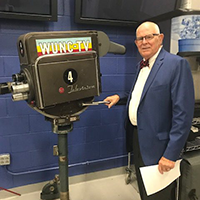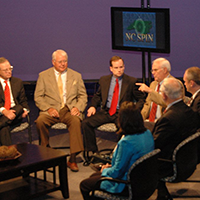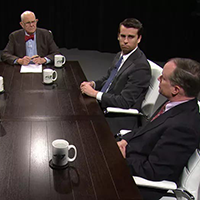Short-sighted politics threatens to unravel Renewable Energy
Published April 3, 2013
by Jeanne Milliken Bonds
Jeanne Milliken Bonds began working on energy policy issues in Washington, DC in 1985
The triple threat -Americans for Tax Reform, Americans for Prosperity and the John Locke Foundation - are all coming together in a "save the day" siege on the State's Renewable Portfolio Standard (RPS) with their usual loose language combined with rhetoric and half the story. They are predicting that there will be a play for a national RPS in their usual highly theatrical doomsday prediction.
Let's do the politics first. Former President George Bush must be grimacing with distress since he signed the Texas RPS as Governor of Texas in 1999. Former Vice Presidential Candidate Sarah Palin must also be tossing and turning since she outlined a plan for 50 percent renewable energy in Alaska when she was Governor. I bring up these two Republicans because Americans for Prosperity has been tweeting the lights out with "Obama energy tax" and spreading their alert calling it the same. A usual tactic of dumbing voters down by pinning it on someone who was not even a player in politics when the first RPS was adopted in Iowa in 1983. Reagan was President.
President Reagan cut the renewable energy R&D budget 85 percent after he took office and eliminated the wind investment tax credit in 1986. He gutted President Carter's clean energy and energy efficiency effort and rolled back fuel economy standards. One could argue that had the R&D not been cut by Reagan, Treasury Secretary James Baker and their oil-friendly gang, we would not be discussing this issue in 2013.
During the 1980s, we were clawing our way out of an energy crisis. There was a focus on traditional oil and gas supply from unstable regions of the world, controlled by cartels. The national security debate of the day was the interplay between energy and national security. Has that changed? Not at all.
Twenty-nine states, and DC, have an RPS. It was decided in the US Senate that the policy path was for each state to determine its mix, its standards depending on available resources in each State and states have carried on thoughtfully configuring their RPS. There hasn't been further talk of a national RPS except for the usual moaning by the oil and gas lobby. There goes doomsday theory number one - a federal policy.
If Grover Norquist continues snorting the issue about as an "Obama energy tax" in which case he may face a battle just for the political folly of it all. And, traveling to the "red" states to repeal the RPS looks like a challenge to actually push it at the national level. Thanks Grover. One more reason we can divert focus from the budget and the economy. But remember that is what these folks need and want - an issue to hustle so they have a job. So, while North Carolina continues to flatline on jobs and unemployment ticks up, these folks can sleep at night creating a new "fight" so they have a job.
Doomsday theory two - more government in business utilities. Well, some states are regulated energy markets and some are deregulated. It is hard to take government out in a regulated state energy market. That is the whole point of regulation. North Carolina is regulated.
Of all the state-based RPS programs in place today, no two are the same. Each was designed taking into account state-specific policy objectives (economic growth, diversity of energy supply, environmental concerns), local resource endowment, political considerations, and the capacity to expand renewable energy production.
Different states have different targets at different intervals. At the most basic level, this gives rise to differing RPS targets and years for achieving the targets. Many other factors occur in state RPS plans - which resources, new build, technologies, cost recovery, trading. North Carolina's investor-owned utilities met 3 percent of 2011 sales in 2012, and then ramp up in increments over time to 12.5 percent of 2020 sales by 2021 and each year thereafter. The remaining electric service providers (rural electric cooperatives and municipal utilities) begin with the same 2012 target, but ramp up instead to 10 percent of 2017 sales by 2018, and for each year thereafter. The REPS also includes specific technology requirements for solar energy, swine waste, and poultry waste.
Doomsday theory three - availability. I had to chuckle at Becki Gray's commentary with the John Locke Foundation: "Solar, wind, and biomass offer unreliable and expensive energy. The sun doesn't always shine, the wind doesn't always blow, and none of these volatile sources can meet a consistent or peak demand for electricity."
That's why the RPS is 12.5 percent of total sales by 2021. Even if the clean energy resources did produce all the time, our outdated grid that moves the energy from place to place could not handle the generation nor could we store the energy. Oil doesn't always pump either, and sometimes it spills requiring clean-up. Nuclear depends on uranium, mined in some rather unstable regions, subject to price fluctuations. And, it is difficult to store natural gas for a cloudy day.
Doomsday theory four - real costs. Do you know why renewable energy costs more than traditional sources? 1) Reagan delayed the R&D for alternative fuels. 2) The traditional fuels are heavily subsidized and always have been, by your federal tax dollars.
These groups argue that consumers are being taxed to create markets for renewables. Where is the outrage for those subsidies?
The subsidies the nuclear and fossil-fuel industry receive and have received for many years make their product “affordable.” Those subsidies take many forms, but the costs are market "externalities" are real costs pushed off on me and you instead of being paid by the companies.
Typically as an industry matures, subsidies decline. Not so because so many of our political windbags are powered by oil and gas money in the form of political contributions. Timber, coal, oil and gas, nuclear received substantial government support at a pivotal time in their early growth, and those subsidies continue today. Of course they are cheaper. We are paying for them over and over again. That is not true of renewable energy sources. And now as you fight to take those standards out of the market, there will never be a time to invest in alternatives to diversify our energy so the subsidies for traditional energy will continue forever. Short-sighted. Non-innovative.
Energy industries have enjoyed a century of federal support and it is in the half a trillion range. Average annual support for the oil and gas industry and nuclear is in the $3-5 billion range. Why should traditional energy innovate when they get free government money?
Fossil fuels get foreign tax credit, credit for production of non-conventional fuel, oil and gas exploration and development. Nuclear is a base-load energy source and without subsidies, it would not exist. Who would cover the insurance on a nuclear plant? We do. Take a look at the National Energy Policy Act of 2005 because it is filled with subsidies and tax breaks, unlimited taxpayer-backed loan guarantees, limited liability in the case of an accident, liability caps, incentives for new designs, production tax credits, clean up funds, risk insurance, R&D and other incentives to the mature nuclear industry to build new nuclear reactors.
Your electric bill includes a cost for the unfinished Yucca Mountain Used Fuel Depository for used nuclear fuel. January 2013 marked 15 years since the federal government defaulted on its legal responsibility to store our nation’s nuclear waste. According to the law, the Department of Energy was supposed to begin accepting nuclear waste at Yucca Mountain by January 31, 1998. Since then, 76 lawsuits have been filed over DOE’s failure to meet its obligation, costing taxpayers over $1.6 billion dollars. Liability costs are estimated to total $19.1 billion through 2020, and $500 million for each year of delay after that. That's for nuclear.
Yes, you pay for electricity in your electric bill and then again in your taxes through a myriad of subsidies created and continued for a century. Money to expand businesses, hire new workers, or invest in new ideas has been thrown into old industries without any incentive to innovate. That's an idea that has run its course. To use Becki's line more accurately - these old industries should be able to stand on their own without big government subsidies.
Jeanne Bonds is a political analyst and an NC Spin Panelist







